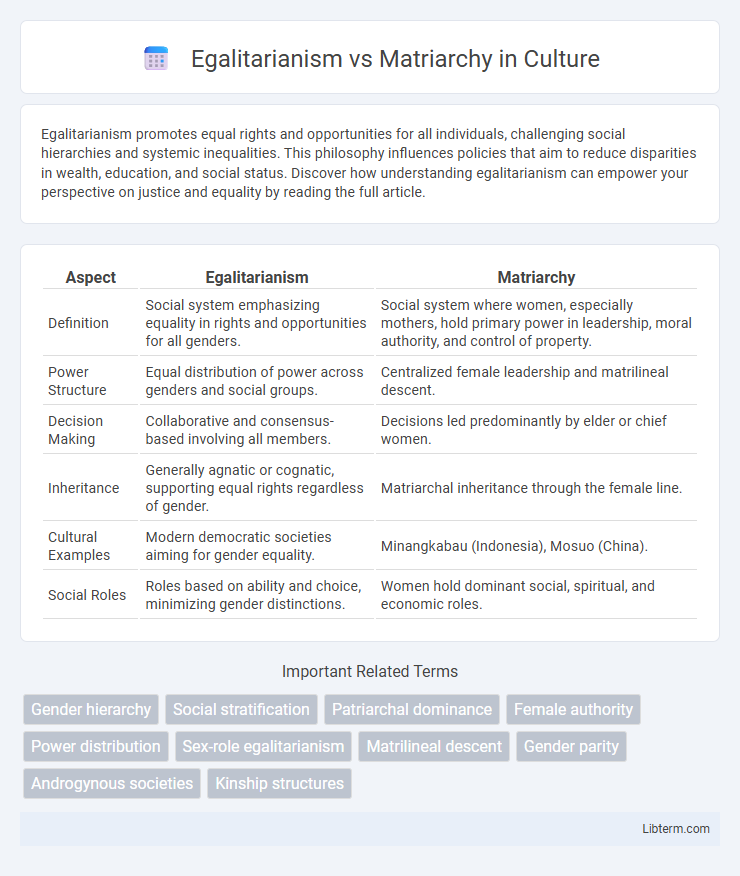Egalitarianism promotes equal rights and opportunities for all individuals, challenging social hierarchies and systemic inequalities. This philosophy influences policies that aim to reduce disparities in wealth, education, and social status. Discover how understanding egalitarianism can empower your perspective on justice and equality by reading the full article.
Table of Comparison
| Aspect | Egalitarianism | Matriarchy |
|---|---|---|
| Definition | Social system emphasizing equality in rights and opportunities for all genders. | Social system where women, especially mothers, hold primary power in leadership, moral authority, and control of property. |
| Power Structure | Equal distribution of power across genders and social groups. | Centralized female leadership and matrilineal descent. |
| Decision Making | Collaborative and consensus-based involving all members. | Decisions led predominantly by elder or chief women. |
| Inheritance | Generally agnatic or cognatic, supporting equal rights regardless of gender. | Matriarchal inheritance through the female line. |
| Cultural Examples | Modern democratic societies aiming for gender equality. | Minangkabau (Indonesia), Mosuo (China). |
| Social Roles | Roles based on ability and choice, minimizing gender distinctions. | Women hold dominant social, spiritual, and economic roles. |
Understanding Egalitarianism: Core Principles
Egalitarianism emphasizes equal rights, opportunities, and treatment for all individuals regardless of gender, race, or social status, fostering a society where power and resources are fairly distributed. Its core principles include fairness, justice, and the dismantling of hierarchical structures that perpetuate inequality. Contrasting with matriarchy, which centralizes female authority, egalitarianism advocates for balanced participation and shared authority among all genders.
Defining Matriarchy: Key Characteristics
Matriarchy is a social system where family lineage, inheritance, and authority are traced through the female line, often granting women central roles in social, political, and economic domains. Key characteristics of matriarchy include female leadership in governance, matrilineal kinship, and the prioritization of women's roles in decision-making processes. Unlike egalitarianism, which seeks equal power distribution across genders, matriarchy specifically elevates women's status and influence within society.
Historical Roots of Egalitarian Societies
Egalitarian societies have roots in early hunter-gatherer groups where resource sharing and collective decision-making were essential for survival, fostering social equality. Archaeological evidence from Paleolithic sites reveals relatively equalitarian social structures with minimal hierarchical distinctions. Unlike matriarchal systems centered on female authority, egalitarianism emphasizes balanced power distribution irrespective of gender, highlighting diverse cultural practices across prehistoric and tribal communities.
The Evolution of Matriarchal Systems
Matriarchal systems have evolved as social structures where women hold primary power roles in leadership, moral authority, and control over property, contrasting with egalitarian societies that emphasize equal rights and responsibilities regardless of gender. Archaeological evidence from Neolithic communities indicates that early human groups may have practiced matrilineal descent and matrifocal residence patterns, underpinning the development of matriarchies. Over time, matriarchal systems adapted to complex societal needs but were often supplanted or integrated into patriarchal or egalitarian frameworks as cultural and economic dynamics shifted.
Gender Roles in Egalitarianism vs Matriarchy
Egalitarianism promotes equal gender roles, emphasizing shared responsibilities and decision-making power between men and women. In contrast, matriarchy centers authority and social roles around women, often assigning men more subordinate or complementary roles. Gender roles under egalitarianism are flexible and based on individual merit, while matriarchy structurally prioritizes female leadership and influence in societal and familial contexts.
Economic Structures: Equality or Female Leadership?
Egalitarianism promotes economic structures based on equal access to resources, opportunities, and wealth distribution regardless of gender, fostering balanced economic participation and decision-making. Matriarchy centers economic leadership and control primarily in the hands of women, with female authority guiding resource allocation, labor division, and wealth management within communities. These contrasting frameworks influence market dynamics, social capital, and economic resilience by either emphasizing equality across genders or privileging female leadership in economic roles.
Political Power Dynamics Compared
Egalitarianism advocates for equal political power distribution across all genders, promoting inclusive decision-making and preventing dominance by any single group. Matriarchy centralizes political authority in female leaders or institutions, often emphasizing matrilineal descent and prioritizing women's roles in governance. The power dynamics in egalitarian systems strive for balance and equality, whereas matriarchal structures emphasize female-centric authority and cultural norms.
Social Justice and Inclusivity: Contrasts and Intersections
Egalitarianism advocates for equal rights and opportunities regardless of gender, emphasizing social justice through the elimination of systemic inequalities. Matriarchy, as a social structure where women hold primary power, offers a framework to explore inclusivity by centering female leadership and perspectives often marginalized in patriarchal societies. Both concepts intersect in their pursuit of dismantling oppression but contrast in their approach: egalitarianism promotes gender neutrality, while matriarchy values female empowerment as a corrective to historical gender biases.
Contemporary Examples Around the World
Contemporary examples of egalitarian societies include the Scandinavian countries such as Sweden and Norway, which prioritize gender equality through progressive policies and social welfare systems. In contrast, matriarchal structures are observed in communities like the Mosuo in China, where women hold primary authority in family and social matters. These distinct social models highlight the varying approaches to power distribution and gender roles across cultures today.
Future Prospects: Trends and Global Debates
Future prospects of egalitarianism reveal growing advocacy for equal rights across genders, emphasizing policy reforms and inclusive governance models worldwide. Matriarchy, while less prevalent, attracts scholarly interest as a potential framework for addressing gender imbalances and promoting sustainable social systems. Global debates increasingly explore hybrid societal structures, balancing egalitarian principles with matriarchal values to enhance social equity and cultural diversity.
Egalitarianism Infographic

 libterm.com
libterm.com